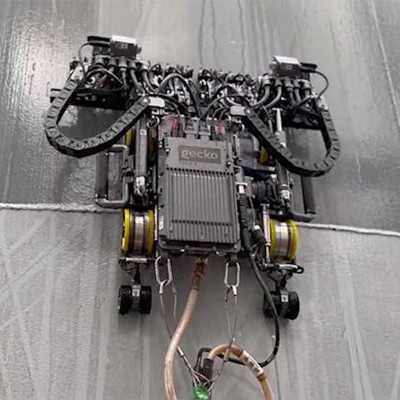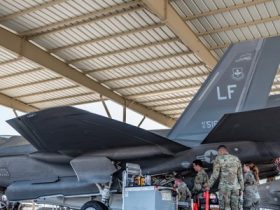A new partnership between a defense AI startup and a ship builder aims to accelerate the construction and maintenance of new American ships at a time when the Chinese Navy’s shipbuilding capacity is far outpacing the United States’.
The partnership between Gecko Robotics—a company that uses AI and drones to accelerate maintenance—and BPMI was announced Tuesday in Pittsburgh, where President Donald Trump was meeting with AI companies and researchers.
BPMI is the prime contractor for the Navy’s nuclear propulsion program, tasked with “engineering, procurement, and technical oversight of naval nuclear components,” according to the Navy. That includes the development of the Columbia nuclear submarine, scheduled for initial operating capability in 2030, as well as the maintenance and modernization of the Ohio class and Virginia-class nuclear attack submarines. The Navy currently has a program to adapt the Virginia-class for more high-tech missiles through its Block V program.
Nuclear sub-building is an arduous endeavour, complicated more by the strict requirements in place to assure that submarines can withstand massive pressures and conditions of submersion for long periods. Building a new submarine requires a large number of contractors who all have their own record-keeping processes, which can result in delays in exchanging thousands of paper files throughout the manufacturing process. That’s one reason an April 2025 report from the GAO found that the Block V program was only at 60 percent of its annual goal in terms of output.
“If you’re building a nuclear sub, you’ve got 400,000 vendors all going into making that whole thing go. They’re all handing paper to each other.” Jake Loosararian, co-founder and CEO of Gecko Robotics, told Defense One. But Gecko’s AI can help speed that process, he said.
The company also makes drones that can conduct highly detailed inspections, including of material strength. “You want to know the structural integrity, like the actual metal, what’s the health of every layer of that metal.”
All that data can then be incorporated into the company’s digital twinning software, which allows for the creation of highly realistic virtual versions of vehicles and devices to illustrate problems. By structuring data across various sources, Loosararian says Gecko is able to speed up production by 90 percent (Defense One was unable to independently verify this.)
More importantly, Loosararian says the spread of these processes and techniques could help relieve the shortage of highly skilled workers in difficult-to-train professions like ship-building. “Both commercial and defense ship building just comes down to, how do you supercharge our men and women with tools so that they don’t have to have 10 to 20 years of welding experience to be able to contribute?” he said.
Ship building and maintenance as a strategic weakness
The slowness and cost of maintenance is causing “significant impacts to global operations,” Rep. Ken. Calvert, R-Calif., observed in a May, 2024 hearing on naval readiness. Maintenance issues already plague virtually every service. But in the event of a conflict with China, the impacts could balloon.
Maintenance time and cost may not sound like the sort of issue that could lead to a defeat in a major conflict. But it adds to a significant gap the U.S. already faces against China.
The Chinese naval fleet is already much larger than the U.S. Navy’s—297 versus 400—and the Government Accountability Office expects that number to grow, with China on track to have 435 ships in operation in 2030. That’s compared to the U.S. goal of 381 ships by that time.
And ongoing maintenance issues could sideline the ships the U.S. does have. In a July 2023 op-ed for the Wall Street Journal, Senate Armed Services Committee co-chair Sen. Roger Wicker, R-Miss., said 40 percent of all U.S. attack submarines can’t be deployed at any given time because they’re stuck in maintenance.
The discrepancy in the numbers also reveals an additional problem: China has far more shipyards and ship building capacity—53 percent of global shipbuilding capacity compared to less than 1 percent for the United States, according to a May estimate from Georgetown. So China’s ships are newer, require less maintenance, and because they have more shipyards, that maintenance happens faster.
The Navy hopes robotic and autonomous vessels can help cover that gap. But it still needs manned surface vessels and submarines.
Gecko is already working with the Navy to speed maintenance of aircraft carriers and submarines.
Speaking at the Defense One Tech Summit in June, Gecko Robotics co-founder Troy Demmer described how the company speeds up the maintenance process: “We’re leveraging autonomy and AI to deploy technologies prior to a ship or a submarine coming into a dry dock facility so that we have an understanding of, ‘What’s the material health of this asset? How do we make targeted, efficient repairs so that we can get that asset back in the fight?”
Integrating autonomous inspection and AI repair analysis into the production of new ships, rather than just maintenance, can also help the process move faster, he said.
“We’re deploying autonomy and robotics as well in the supply chains, way upstream of the shipyards even. So, how do we get forging and castings produced more efficiently…Because we are talking millions of dollars being lost when that part has to get scrapped.”
Read the full article here








Leave a Reply